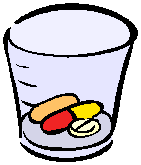Treatments
Presently there is no cure for HIV. Vaccines are under development but are not yet available.
Medications
There are six major types of drugs used to treat HIV/AIDS. Called antiretrovirals because they act against the retrovirus HIV, these drugs are grouped by how they interfere with steps in HIV replication .
- Entry Inhibitors interfere with the virus' ability to bind to receptors on the outer surface of the cell it tries to enter. When receptor binding fails, HIV cannot infect the cell.
- Fusion Inhibitors interfere with the virus's ability to fuse with a cellular membrane, preventing HIV from entering a cell.
- Reverse Transcriptase Inhibitors prevent the HIV enzyme reverse transcriptase (RT) from converting single-stranded HIV RNA into double-stranded HIV DNA―a process called reverse transcription. There are two types of RT inhibitors:
1. Nucleoside/nucleotide RT inhibitors (NRTIs) are faulty DNA building blocks. When one of these faulty building blocks is added to a growing HIV DNA chain, no further correct DNA building blocks can be added on, halting HIV DNA synthesis.
2. Non-nucleoside RT inhibitors (NNRTIs) bind to RT, interfering with its ability to convert HIV RNA into HIV DNA
- Integrase Inhibitors block the HIV enzyme integrase, which the virus uses to integrate its genetic material into the DNA of the cell it has infected.
- Protease Inhibitors interfere with the HIV enzyme called protease, which normally cuts long chains of HIV proteins into smaller individual proteins. When protease does not work properly, new virus particles cannot be assembled.
- Multi-class Combination Products combine HIV drugs from two or more classes, or types, into a single product.
To prevent strains of HIV from becoming resistant to a type of antiretroviral drug, healthcare providers recommend that people infected with HIV take a combination of antiretroviral drugs in an approach called highly active antiretroviral therapy (HAART). Developed by NIAID-supported researchers, HAART combines drugs from at least two different classes.
The success of this therapy is dependent not only on the HAART treatment plan, but also on the patient's ability to strictly adhere to the new medication regimen and tolerate the side effects of these powerful drugs. Side effects that may seem minor, such as fever, nausea, and fatigue, can mean there are serious problems. More serious side effects of HAART are:
- liver problems,
- diabetes,
- fat maldistribution (lipodystrophy syndrome),
- high cholesterol,
- increased bleeding in patients with hemophilia,
- decreased bone density, and skin rash
Antiretroviral drugs used in the treatment of HIV infection

